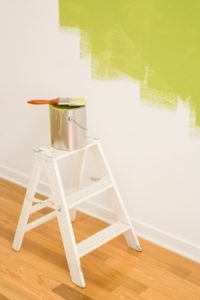Create Added Texture Subhead Through Sponge Painting
One of the most popular designer modifications you can make when painting a room is to use the sponging technique. Sponging creates dimension and depth that would otherwise not exist on a flat wall. And while sponging is not complicated, it does require advanced interior painting proficiency to ensure a quality outcome for your living room, den or kitchen.
 Required Paint Supplies
Required Paint Supplies
Since you have previous painting experience, you will likely have most paint supplies on hand. However, there are a few extra craft tools you will need to purchase before you can begin.
Needed Items
Shop as usual for your paint tray, liner and paint roller. You will also need to purchase a base paint to cover all the walls. In addition, you will buy some top coat/color paint and some faux glaze that will be used for actual sponging. To apply the swirled, textured look you will also need to purchase a natural sponge (we recommend buying several), a bucket, a stirring stick and rubber gloves.
Painting the Room
Before preparing the room for painting, practice the sponging technique below on an old piece of wood. Once confident about the process, prepare the room and walls as usual. Next, paint the walls with your base paint, which is most often a flat, satin, eggshell or semi-gloss interior paint.
Once walls are dry, pour 1-part of top paint to approximately 4-parts faux glaze in a bucket and stir. More faux glaze creates a transparent-looking top coat while less faux glaze creates a deeper, denser look.
Begin Sponging
Dampen the natural sponge and then dip it into the glaze bucket, blotting any excess glaze off the sponge. Begin by lightly pressing the sponge against the wall and tamping it in a random circular motion, leaving a light coat of glaze on top of the wall’s undercoat of paint. It is important to not press down hard as it will leave too much glaze on the wall. Next, roll the sponge over the wall surface to continue the random-looking effect over more wall area.
When your sponge is void of glaze, re-dip it to apply new strokes, repeating the process until you have covered the entire room. Don’t try to cover too much area at once. It is best to work in small areas to keep sponging edges wet for an even-looking consistent effect. For wall edges and corners, you may need to use a smaller portion of sponge to cover it. Once the entire room is done, ensure that all areas have been sponged, touching up as needed.